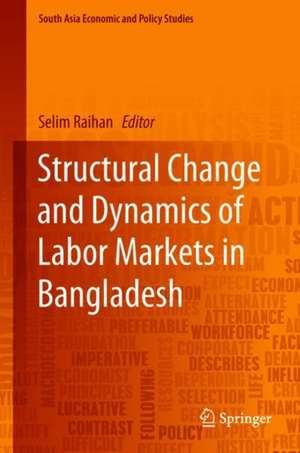Structural Change and Dynamics of Labor Markets in Bangladesh: South Asia Economic and Policy Studies
Editat de Selim Raihanen Limba Engleză Hardback – 18 sep 2018
| Toate formatele și edițiile | Preț | Express |
|---|---|---|
| Paperback (1) | 637.59 lei 6-8 săpt. | |
| Springer Nature Singapore – 11 ian 2019 | 637.59 lei 6-8 săpt. | |
| Hardback (1) | 643.84 lei 6-8 săpt. | |
| Springer Nature Singapore – 18 sep 2018 | 643.84 lei 6-8 săpt. |
Preț: 643.84 lei
Preț vechi: 757.46 lei
-15% Nou
Puncte Express: 966
Preț estimativ în valută:
123.21€ • 129.55$ • 101.80£
123.21€ • 129.55$ • 101.80£
Carte tipărită la comandă
Livrare economică 16-30 aprilie
Preluare comenzi: 021 569.72.76
Specificații
ISBN-13: 9789811320705
ISBN-10: 9811320705
Pagini: 160
Ilustrații: XXXII, 205 p. 91 illus.
Dimensiuni: 155 x 235 mm
Greutate: 0.51 kg
Ediția:1st ed. 2018
Editura: Springer Nature Singapore
Colecția Springer
Seria South Asia Economic and Policy Studies
Locul publicării:Singapore, Singapore
ISBN-10: 9811320705
Pagini: 160
Ilustrații: XXXII, 205 p. 91 illus.
Dimensiuni: 155 x 235 mm
Greutate: 0.51 kg
Ediția:1st ed. 2018
Editura: Springer Nature Singapore
Colecția Springer
Seria South Asia Economic and Policy Studies
Locul publicării:Singapore, Singapore
Cuprins
Chapter 1: Structural Change in Bangladesh: Challenges for Growth and Employment Creation (by Selim Raihan).- Chapter 2: What determines the Choice between Farm and Nonfarm Employments in the Rural Bangladesh? (Selim Raihan and Syer Tazim Haque).- Chapter 3: How does Employment Status Matter for the Wellbeing of Rural Households in Bangladesh? (Selim Raihan and Fatima Tuz Zohora).- Chapter 4: Female Labor Market Participation in Bangladesh: Structural Changes and Determinants of Labor Supply (Simeen Mahmud and Sayema Haque Bidisha).- Chapter 5: Unpacking Unpaid Labor in Bangladesh (Selim Raihan, Sayema Haque Bidisha and Israt Jahan).- Chapter 6: Dynamics of Employment in the Urban Informal Sector in Bangladesh (Selim Raihan, K. M. Nafiz Ifteakhar and Mir Tanzim Nur Angkur).- Chapter 7: Some Estimates of First Demographic Dividend in Bangladesh: An Application of the Bangladesh National Transfer Account (Bazlul Haque Khondker and Muhammad Moshiur Rahman).- Chapter 8: How does Social Protection affect Labor Force Participation in Bangladesh? (Selim Raihan and Israt Jahan).- Chapter 9: How do Education and Skill development affect the Transition from ‘Good-enough’ Job to ‘Decent’ Job? (Selim Raihan and Mahtab Uddin).- Chapter 10: Does Participation in Vocational Training Differ on Agricultural Seasonality? (Israt Jahan and Abu S. Shonchoy).- Chapter 11: How does Remittance affect Labor Force Participation Behavior and Employment Choice in Bangladesh? (Selim Raihan, Muhammad Moshiur Rahman, Andilip Afroze and Mahtab Uddin).- Chapter 12: Growth and Distributional Impacts of Exogenous Demand Shock in Selected Activities in Bangladesh: Application of the Social Accounting Matrix Framework (Bazlul H. Khondker).- Chapter 13: Economy-wide and Employment Effects of different Scenarios in Bangladesh: Application of a CGE Model (SelimRaihan).
Notă biografică
Dr. Selim Raihan is a Professor at the Department of Economics, University of Dhaka, Bangladesh and Executive Director of the South Asian Network on Economic Modeling (SANEM). His areas of interest include international trade and trade policy issues related to regional trading agreements, the WTO and domestic trade policies. He has extensive research experience in regional trade and development issues in South Asia, poverty and inequality issues, labor market issues, analysis of economic growth, political economy analysis of growth and development, and economic modeling.
Textul de pe ultima copertă
Outlining important policy requirements for Bangladesh to become an upper middle-income country, the book presents research work conducted during the project “Changing Labor Markets in Bangladesh: Understanding Dynamics in Relation to Economic Growth and Poverty,” sponsored by the International Development Research Center (IDRC), Canada. Bangladesh has experienced remarkable economic growth rates over the last decade. The country has recently been upgraded from a low-income country (LIC) to a lower-middle-income country (LMIC) as per the World Bank’s classification system. By 2024, the country also aspires to graduate from the United Nation’s list of least developed countries (LDC). The 7th five-year plan sets an ambitious target of 8 percent growth in GDP by 2020. There are also steep development targets to be achieved under the Sustainable Development Goals (SDGs) by 2030. All these will require an enormous leap forward from the current level of economic growth rate and sustaining itin the future. The situation also calls for considerable structural change in the economy, facilitating large-scale economic diversification. Rapid expansion of labor-intensive and high-productivity sectors, both in the farm and nonfarm sectors, is thus crucial for Bangladesh. Further, this should take place in conjunction with interventions to enhance productivity, jobs and incomes in traditional and informal activities where there are large pools of surplus labor. Given its relevance for Bangladesh and applicability to many other developing countries, the book offers a unique and pioneering resource for researchers, industry watchers as well as policy makers.
Caracteristici
Offers comprehensive information on structural change and the dynamics of labor markets in Bangladesh Includes empirical analysis of critical issues related to the labor market in Bangladesh Presents analysis relevant for many developing countries









